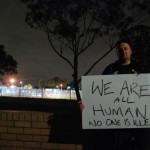By Stephen de Tarczynski
MELBOURNE, Apr 19 (IPS) – Supporters of asylum seekers here say that the government’s response to recent
suicides in Australian immigration detention centres ignores what is already
well-known: that indefinite, long-term detention in crowded facilities results in
deaths.
“We’ve had so many reviews and they’ve all pointed to the same thing,” says Ian Rintoul, spokesperson
for the Refugee Action Coalition (RAC), which has been vocal in calling on successive governments to
abandon the policy of mandatorily detaining “unauthorised arrivals”.
Under this policy, people are held while identity, health and security checks are carried out. These
checks can take considerable time.
Rintoul says that there are thousands of people who have languished in immigration detention for six
months or more, and hundreds who have been detained from one year to 18 months. Several have been
held for even longer.
“Until you deal with the underlying cause, until you deal with the lack of certainty and the anxiety
associated with mandatory detention, nothing is going to change. It’s very obvious.”
Refugee advocates and human rights defenders are among those who have long been opposed to what
they regard as the harsh, unfair treatment of those who claim asylum in Australia, often fleeing
persecution in their homeland.
The Refugee Council of Australia, the national body representing more than 130 organisations, has
been calling on the governing Labour party to abolish indefinite, mandatory detention and implement
the reforms it announced back in 2008.
The government’s pledges included ending what then minister for immigration Chris Evans called
“dehumanising” long-term detention and removing children from immigration centres. But these have
never been put into practice.
“We would say that the system is broken,” says the Council’s Sophie Peer.
The latest available figures from the department of immigration and citizenship (DIAC) show that there
were 6,758 people in Australian immigration detention on Feb.18, up from less than 500 midway
through 2009. More than 95 percent of these are asylum seekers who arrived here by boat, labelled by
authorities as “irregular maritime arrivals”.
One of these “irregulars” was a 20-year-old Afghani who was found dead at the Curtin Immigration
Detention Centre in Australia’s remote north-west late last month. While DIAC has not released details
about the young man’s death, refugee advocates have identified him as Mohammed Asif Atay.
According to advocates, he hanged himself on Mar. 28, allegedly in response to delays and a lack of
information regarding his application for asylum.
The Curtin facility was controversially reopened in June last year for Australia’s spiralling immigration
detainee population after it had been closed in 2002 following a spate of protests and self-harm
incidents.
Mohammed’s death followed the apparent suicide of another 20-year-old male detainee from
Afghanistan, also an “irregular maritime arrival”, on Mar. 16 at the Scherger Immigration Detention
Centre in north-eastern Australia.
These cases brought the total number of suicides among the immigration detention population in a
six-month period to five.
A Fijian national committed suicide at the Villawood facility in Sydney last September and an Iraqi man
killed himself there in November. Also at Villawood, a British man detained for breaching his visa
conditions committed suicide in December.
DIAC has reacted to these deaths by recently agreeing to establish an independent review of mental
health services available to those held in its immigration detention centres. This decision was
apparently based on advice the department received last December from its Detention Health Advisory
Group (DeHAG), whose work focuses particularly on issues of mental health.
“The department is progressing a review of the psychological support programme and its
implementation within places of immigration,” a DIAC spokesperson confirmed to IPS on Apr.15, adding
that the organisation or person to undertake the review has yet to be determined.
Prof. Louise Newman, director of the Centre for Development Psychology and Psychiatry at the Monash
Medical Centre in Melbourne and chair of DeHAG, says that although the impact of the mandatory
detention regime on detainees’ mental health is well known, the review represents an opportunity to
alter the atmosphere inside the detention system.
She argues that DeHAG has been attempting to instil “a culture within the detention centres that is not
about law and order and maintaining a population in a state of virtual imprisonment. It’s also about
looking at how we might have a better system that actually recognises the vulnerabilities of these
people and prevents some of the incidents that we’ve seen.”
But with suicides and incidents of self-harming continuing, DeHAG appears to have much to do.
A 26-year-old Tamil man who had recently been transferred to Curtin from Australia’s offshore
detention centre on Christmas Island attempted suicide on Mar. 30, as did a 30-year-old Afghan
national on Apr. 7.
The RAC’s Ian Rintoul says the situation at Curtin is critical.
“I’m told both by detainees and people who work there in various capacities that you’re looking at a
self-harm incident, effectively, daily.”
For Rintoul, the review of mental health services will only amount to an audit that will highlight the
inadequacy of what is offered to detainees. He argues that psychologists, psychiatrists and pills are not
what people in immigration detention require.
“What they need is to get out…until that’s remedied, we are simply going to see repeats – and constant
repeats – of the self-harming and attempted suicides that we’ve got now.”






